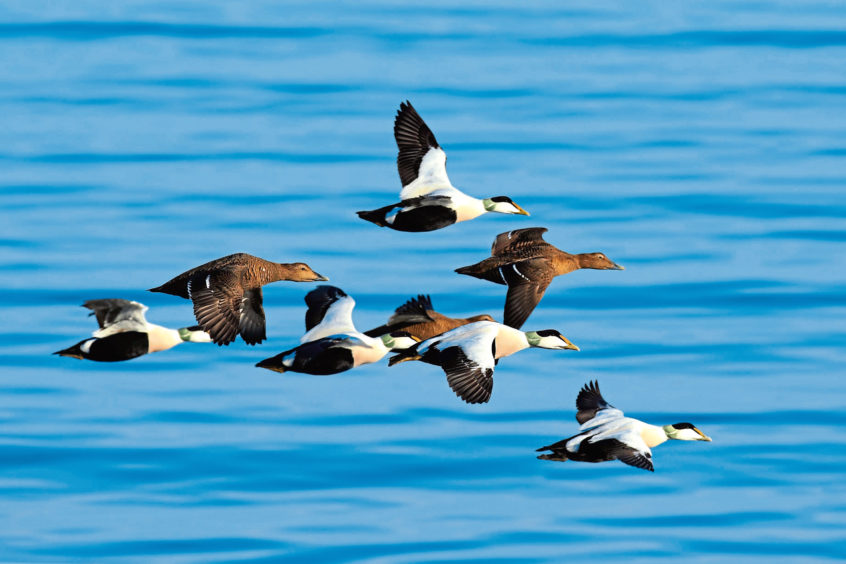Many years ago I bought a small unsigned oil painting of storm-driven waves crashing onto rocks at the foot of high cliffs.
The cliffs were the Bullers of Buchan, a spectacular natural arch projecting out into the sea, and what is known locally as the Cauldron or The Pot into which the sea churns and boils in wild weather.
According to my ever-helpful Dr Jamieson’s Etymological Dictionary of the Scottish Language, Buller is derived from the French bouillir, to boil.
Ever since I bought that wee painting I’d promised myself I’d take a trip up there and walk to the Bullers to see just how impressive they are.
It wasn’t on my bucket list, you understand – I’m too young for one of those – but it was something that always got put off in favour of some other ploy.
No excuse to stay home
I ran out of excuses last weekend and, bundling Inka into the car, the Doyenne and I set off up the coast, heading for the other end of Aberdeenshire, near Peterhead.
Driving out of Laurencekirk the brown earth of Angus changes to the bright red clay and rich brown earth of The Mearns.
The farmers will soon be finished drilling and sowing this year’s crops and it won’t be long until the bare fields are sprouting the fresh green shoots of spring.
Past Stonehaven the landscape changes to the coastal plain. We left the Aberdeen by-pass and took the A975 on the coastal route.
We were ready for our picnic, and turning off the main road at the outskirts of Newburgh we drove down and parked by the side of the wide estuary of the River Ythan.
With nesting in full swing there wasn’t much bird activity other than five eider duck drakes and a raft of noisy black headed gulls chattering and quarrelling amongst themselves.
St James’s Cruden Bay church sits by the roadside. I suspect its tall, elegant spire can be seen by vessels out at sea and will have been a valuable navigation mark for mariners, and a fishing mark for generations of fishermen in the days before modern satnav systems.
The small clifftop community of the Bullers of Buchan owed its existence to the tiny cove at the foot of the cliffs where fishermen could beach their boats.
Peter Anson, in his seminal book Fishing Boats and Fishing Folk on the East Coast of Scotland, reckoned that there was a village of fisherfolk at the Bullers for about a century and that there were as many as twenty boats and thirty fishermen.
It’s hard to conceive from today’s perspective what a hard, grinding life the fishermen and their families led.
Their source of livelihood lay at the foot of a steep path to the shore and everything, from their gear to their catches, had to be carried on their backs down and up that path.
They went out in fifteen foot skiffs, clinker built, without any protective decking, open to the elements to fish for haddock, whiting and cod.
At the mercy of weather, wind and tide
Some boats had a square-shaped lug sail, but often none, all the work being done with oars.
They were very much at the mercy of the weather, wind and tide. If the wind changed while they were at sea, or dirty weather blew up, it could be difficult, maybe impossible, to get back to the safety of their exposed beach.
A fisherman’s wife’s day was spent wondering if her husband would return to his family in the evening.
Her job was arduous too. In addition to their “domestic duties” the wives baited their husbands’ lines, prepared the fish for sale, and set off daily with a heavy creel of fish on their backs to sell it round the countryside.
Beyond the cottages a narrow track runs rather closer for comfort in places along the edge of two hundred foot cliffs. I kept Inka firmly to heel as the grass on the cliff top is slippy and it’s a long drop to oblivion.
The weather was unpredictable – sleety rain one minute and bright sunshine the next
The red granite cliffs are getting busy at this time with nesting seabirds. There is a colony of puffins and fulmars and kittiwakes are pairing up.
You can expect to see shags and guillemots, and it’s a viewpoint for dolphin watching. But it’s early yet for the spring wildflowers.
Then it was time to set off home. The fertile plain of Buchan, known as the granary of Aberdeen, stretched away westwards. Breaking the horizon was Bennachie and its three misty peaks of Oxen Craig, Millstone Hill and Mither Tap.
Perhaps we should have waited for better weather for our visit – but that would have been just another excuse not to go.
Anyway, we’ve decided our next visit to the area will be to Slains Castle, five miles down the coast and said to be the inspiration for the setting of Bram Stoker’s Gothic horror novel, Dracula.
That’ll send a shiver down the Doyenne’s spine.














